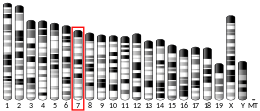TBX6
T-box 6 is a protein that in humans is encoded by the TBX6 gene.[5]
Function
This gene is a member of a phylogenetically conserved family of genes that share a common DNA-binding domain, the T-box. T-box genes encode transcription factors involved in the regulation of developmental processes. Knockout studies in mice indicate that this gene is important for specification of paraxial mesoderm structures.[5]
Tbx6 is also required for the segmentation of the paraxial mesoderm into somites, and for the normal development of the dermomyotome in zebrafish. In the absence of Tbx6, the central dermomyotome of zebrafish fails to develop.[6]
Tbx6 functions in a gene regulatory network with mesp-b and ripply1.[7]
References
- GRCh38: Ensembl release 89: ENSG00000149922 - Ensembl, May 2017
- GRCm38: Ensembl release 89: ENSMUSG00000030699 - Ensembl, May 2017
- "Human PubMed Reference:". National Center for Biotechnology Information, U.S. National Library of Medicine.
- "Mouse PubMed Reference:". National Center for Biotechnology Information, U.S. National Library of Medicine.
- "Entrez Gene: T-box 6".
- Windner SE, Bird NC, Patterson SE, Doris RA, Devoto SH (Aug 2012). "Fss/Tbx6 is required for central dermomyotome cell fate in zebrafish". Biology Open. 1 (8): 806–14. doi:10.1242/bio.20121958. PMC 3507223. PMID 23213474.
- Windner SE, Doris RA, Ferguson CM, Nelson AC, Valentin G, Tan H, Oates AC, Wardle FC, Devoto SH (Mar 2015). "Tbx6, Mesp-b and Ripply1 regulate the onset of skeletal myogenesis in zebrafish". Development. 142 (6): 1159–68. doi:10.1242/dev.113431. PMC 4360180. PMID 25725067.
Further reading
- Farin HF, Bussen M, Schmidt MK, Singh MK, Schuster-Gossler K, Kispert A (Aug 2007). "Transcriptional repression by the T-box proteins Tbx18 and Tbx15 depends on Groucho corepressors". The Journal of Biological Chemistry. 282 (35): 25748–59. doi:10.1074/jbc.M703724200. PMID 17584735.
- Sandbacka M, Laivuori H, Freitas É, Halttunen M, Jokimaa V, Morin-Papunen L, Rosenberg C, Aittomäki K (2013). "TBX6, LHX1 and copy number variations in the complex genetics of Müllerian aplasia". Orphanet Journal of Rare Diseases. 8: 125. doi:10.1186/1750-1172-8-125. PMC 3847609. PMID 23954021.
- Yi CH, Terrett JA, Li QY, Ellington K, Packham EA, Armstrong-Buisseret L, McClure P, Slingsby T, Brook JD (Jan 1999). "Identification, mapping, and phylogenomic analysis of four new human members of the T-box gene family: EOMES, TBX6, TBX18, and TBX19". Genomics. 55 (1): 10–20. doi:10.1006/geno.1998.5632. PMID 9888994.
- Papapetrou C, Putt W, Fox M, Edwards YH (Jan 1999). "The human TBX6 gene: cloning and assignment to chromosome 16p11.2". Genomics. 55 (2): 238–41. doi:10.1006/geno.1998.5646. PMID 9933572.
- Fei Q, Wu Z, Wang H, Zhou X, Wang N, Ding Y, Wang Y, Qiu G (Apr 2010). "The association analysis of TBX6 polymorphism with susceptibility to congenital scoliosis in a Chinese Han population". Spine. 35 (9): 983–8. doi:10.1097/BRS.0b013e3181bc963c. PMID 20228709.
- Sparrow DB, McInerney-Leo A, Gucev ZS, Gardiner B, Marshall M, Leo PJ, Chapman DL, Tasic V, Shishko A, Brown MA, Duncan EL, Dunwoodie SL (Apr 2013). "Autosomal dominant spondylocostal dysostosis is caused by mutation in TBX6". Human Molecular Genetics. 22 (8): 1625–31. doi:10.1093/hmg/ddt012. PMID 23335591.
- Ghebranious N, Blank RD, Raggio CL, Staubli J, McPherson E, Ivacic L, Rasmussen K, Jacobsen FS, Faciszewski T, Burmester JK, Pauli RM, Boachie-Adjei O, Glurich I, Giampietro PF (Oct 2008). "A missense T (Brachyury) mutation contributes to vertebral malformations". Journal of Bone and Mineral Research. 23 (10): 1576–83. doi:10.1359/jbmr.080503. PMID 18466071.
This article incorporates text from the United States National Library of Medicine, which is in the public domain.



